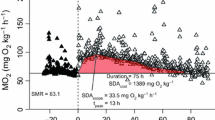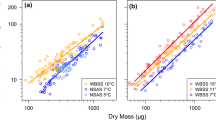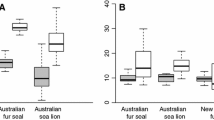Abstract
Fish respiration rates that are presumed to represent standard metabolic rates (SMR) may sometimes include an unspecified energy expenditure associated with activity and digestion. This situation may introduce a bias in bioenergetics models because standard metabolism, digestion, and activity may not be affected by the same environmental conditions. The aim of this study was to (1) develop a SMR model for juvenile yellow perch, Perca flavescens (Mitchill), that represent the minimum energy expenditure required to maintain life and (2) compare the results of this study with published perch metabolic rates and bioenergetics models. SMR was estimated for yellow perch over a range of body␣mass (4.4–24.7 g) and water temperature (12–20°C). The intercept of the relationship between fish respiration and swimming velocity obtained during forced swimming experiments was used to determine SMR. SMR estimated by the present study were comparable to values presented by two published studies on Eurasian perch, Perca fluviatilis L. However, estimated SMR were 4.1–20.9 times lower than values of a third respirometry study and predictions of bioenergetics models for perch. The present study suggests that published SMR models may sometimes include a significant fraction of energy expenditures (39.2–75.9%) associated with digestion and activity. This may complicate the implementation and the interpretation of fish bioenergetics models. The present study indicates that the intercept of respiration-velocity relationships and long-term respiration rates during starvation experiments may provide similar and reliable SMR values.
Similar content being viewed by others
References
APHA (American Public Health Association) (1989) Standard methods for the examination of water and wastewater. 17th editon, Washington, DC
Bajer PG, Whitledge GW, Hayward RS, Zweifel RD (2003) Laboratory evaluation of two bioenergetics models applied to yellow perch: identification of a major source of systematic error. J Fish Biol 62: 436–454
Beamish FWH (1964) Respiration of fishes with special emphasis on standard oxygen consumption, II. influence of weight and temperature on respiration of several species. Can J Zool 42:177–188
Beamish FWH (1978) Swimming capacity. In: Hoar WS, Randall JR (eds) Fish physiology – locomotion. Academic Press, New York, pp 101–187
Beamish FWH, Howlett JC, Medland TE (1989) Impact of diet on metabolism and swimming performance in juvenile lake trout, Salvelinus namaycush. Can J Fish Aquat Sci 46:384–388
Boisclair D (1992) An evaluation of the stereocinematographic method to estimate fish swimming speed. Can J Fish Aquat Sci 49:523–531
Boisclair D (2001) Fish habitat modeling: from conceptual framework to functional tools. Can J Fish Aquat Sci 58:1–9
Boisclair D, Leggett WC (1989) The importance of activity in bioenergetics models applied to actively foraging fishes. Can J Fish Aquat Sci 46:1859–1867
Boisclair D, Rasmussen JB (1996) Empirical analysis of the influence of environmental variables associated with lake eutrophication on perch growth, consumption, and activity rates. Annales Zoologici Fennici 33:507–515
Boisclair D, Sirois P (1993) Testing assumptions of fish bioenergetics models by direct estimation of growth, consumption, and activity rates. Trans Am Fish Soc 122:784–796
Boisclair D, Tang M (1993) Empirical analysis of the influence of swimming pattern on the net energetic cost of swimming in fishes. J Fish Biol 42:169–183
Brandt SB, Mason DM, Patrick EV (1992) Spatially- explicit models of fish growth rate. Fisheries 17:23–35
Brett JR (1964) The respiratory metabolism and swimming performance of young sockeye salmon. J Fish Res Board Canada 21:1183–1226
Brett JR, Groves DD (1979) Physiological energetics. In: Hoar WS, Randall JR, Brett JR (eds) Fish physiology – bioenergetics and growth. Academic Press, New York, pp 279–352
Brill RW (1987) On the standard metabolic rates of tropical tunas, including the effect of body size and acute temperature change. Fish Bull US 85:25–36
Dewar H, Graham JB (1994) Studies of tropical tuna swimming performance in a large water tunnel. 1. Energetics. J Exp Biol 192:13–31
Forstner H, Wieser W (1990) Patterns of routine swimming and metabolic rate in juvenile cyprinids at three temperatures: analysis with a respirometer-activity-monitoring system. Comp Biochem Physiol, B 160: 71–76
Hanson PC, Johnson TB, Schindeler DE, Kitchell JF (1997) Fish bioenergetics model 3.0 Technical Report. University of Wisconsin Sea Grant Institute, Madison
Hewett SW, Johnson BL (1992) Fish bioenergetics model 2.0. Technical Report. University of Wisconsin Sea Grant Institute, Madison, p 79
Huuskonen H, Karjalainen J (1997) Predator-induced respiratory responses in juveniles of vendace Coregonus albula, whitefish C. lavertus, perch Perca fluviatilis and roach Rutilus rutilus. Environ Biol Fish 49:265–269
Karås P (1990) Seasonal changes in growth and standard metabolic rate of juvenile perch, Perca fluviatilis L. J␣Fish Biol 37:913–920
Karås P, Thoresson G (1992) An application of a bioenergetics model to Eurasian perch (Perca fluviatilis L.). J Fish Biol 41:217–230
Kerr SR (1982) Estimating the energy budgets of actively predatory fishes. Can J Fish Aquat Sci 39:371–379
Kitchell JF, Stewart DJ, Weininger D (1977) Applications of a bioenergetics model to yellow perch (Perca flavescens) and walleye (Stizostedion vitreum vitreum). J Fish Res Board Canada 34:1922–1935
MAPAQ (Ministère de l’agriculture, des pêcheries et de l’alimentation du Québec) (1990) Atelier de travail sur la génétique des salmonidés d’élevage au Québec, cahier des conférences. Québec: Gouvernement du Québec
Leonard JBK, Noreika JF, Kynard B, McCormick SD (1999) Metabolic rates in an anadromous clupeid, the American shad (Alosa sapidissima). Comp Biochem Physiol, B 169:287–295
Ney JF (1993) Bioenergetics modelling today: growing pains on the cutting edge. Trans Am Fish Soc 122:736–748
Niimi AJ (1978) Lag adjustment between estimated and actual physiological responses conducted in flow-through systems. J Fish Res Board Canada 35:1265–1269
Reidy SP, Kerr SR, Nelson JA (2000) Aerobic and anaerobic swimming performance of individual Atlantic cod. J Exp Biol 203:347–357
Rice JA, Cochran PA (1984) Independent evaluation of a bioenergetics model for largemouth bass. Ecology 65:732–739
Schaeffer JS, Haas RC, Diana JS, Breck JE (1999) Field test of two energetic models for yellow perch. Trans Am Fish Soc 128:414–435
Smit H (1965) Some experiments on the oxygen consumption of goldfish (Carassius auratus) in relation to swimming speed. Can J Zool 43:623–633
Solomon DJ, Brafield AE (1972) The energetics of feeding, metabolism and growth of perch (Perca fluviatilis L.). J Anim Ecol 41:699–718
Stewart DJ, Weininger D, Rottiers DV, Edsall TA (1983) An energetics model for lake trout, Salvelinus namaycush: application to the Lake Michigan population. Can J Fish Aquat Sci 40:681–698
Thorpe JE (1977) Bimodal distribution of length of juvenile Atlantic salmon (Salmo salar L.) under artificial rearing conditions. J Fish Biol 11:175–184
Ware DM (1975) Growth, metabolism, and optimal swimming speed of a pelagic fish. J Fish Res Board Canada 39:3–13
Ware DW (1978) Bioenergetics of pelagic fish: theoretical change in swimming speed and ration with body size. J␣Fish Res Board Canada 34:220–228
Winberg GG (1956) Rate of metabolism and food requirements of fishes. J Fish Res Board Canada Translation Ser 194(1960):202
Acknowledgements
This work is a contribution to the Groupe de recherche interuniversitaire en limnologie (GRIL) and was supported by a grant from the National Sciences and Engineering Research Council of Canada to D. Boisclair and P. Mangan and by a post-doctoral fellowship from the GRIL to P. Boily. We would like to thank D. Héroux for the help in the experimental design, D. Dumont, J. Dynes, S. Verville and A. Gauthier for capturing the fish, V. Boisvert and P. East for keeping the fish in captivity and D. Bélanger and D. Boula for their assistance during the experiments.
Author information
Authors and Affiliations
Corresponding author
Rights and permissions
About this article
Cite this article
Enders, E.C., Boisclair, D., Boily, P. et al. Effect of body mass and water temperature on the standard metabolic rate of juvenile yellow perch, Perca flavescens (Mitchill). Environ Biol Fish 76, 399–407 (2006). https://doi.org/10.1007/s10641-006-9045-0
Received:
Accepted:
Published:
Issue Date:
DOI: https://doi.org/10.1007/s10641-006-9045-0




